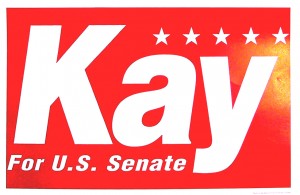How and why yard signs work
 Ben Donahower, of CampaignTrailYardSigns.com, writes in Campaigns and Elections on how to use yard signs to push your campaign over the finish line.
Ben Donahower, of CampaignTrailYardSigns.com, writes in Campaigns and Elections on how to use yard signs to push your campaign over the finish line.
Of particular interest to Libertarian candidates, he writes:
In small races where a candidate isn’t campaigning much at all, the other candidate should frontend sign distribution along with the field campaign as much as possible. If there isn’t the budget for that, putting signs out just a few days or weeks before the election will have an impact. This is in line with a recent study out of Vanderbilt University.
Last year, political scientists, Cindy Kam and Elizabeth Zechmeister found that not only did yard signs increase candidate name recognition but also that nearly one-in-four people who drove by the sign over just a few days time preferred that candidate. In the experiment, the researchers made yard signs for a fictitious candidate, “Ben Griffin” for a real Nashville at-large council seat election. The signs were placed two months out from the election just as campaigns were beginning to connect with voters. Three days after the signs were posted, a local school parent-teacher organization sent out an email asking recipients to take an online survey.
The survey asked respondents who they supported for the at-large Nashville council seat listing five actual candidates and two fictitious ones, including Ben Griffin. Respondents listed their top three choices for the post and nearly 25 percent of those who had driven by the Ben Griffin sign put him in their top three, which was 10-percent higher than the control group. Essentially, not only do yard signs increase name recognition, but they also translate directly into votes in low-information races.
Notice how the study points out voters had “driven by the Ben Griffin sign.” They did not “stop to read the Ben Griffin sign.” That brings up an important point when designing your campaign’s yard sign.
Readability is key, and less is more.
Other than legally-required disclaimers or other language, a yard sign should include only the candidate’s name (generally last name only or most recognizable) and the office he or she seeks (as short as possible.) In some states, you may be required to put “vote for” or “for” if you are not the incumbent.
Generally you do NOT place slogans, your party name, district number, website addresses, photographs or other information on a yard sign. Just name (generally only the last name) and office (as short as possible, such as “State House” instead of “Texas State House of Representatives, District 150.” People know what state they live in, and they don’t need to know their district number. It’s already on the ballot they’re handed.)
People do not READ yard signs, they SEE them. Placing additional text or information offers more distractions in the few seconds a voter sees a sign.
As for colors, white letters on a dark color (blue is best) works best. One color yard signs are generally cheaper than two or more colors.
And don’t waste money on corrugated plastic or plastic bags signs, unless you can get them cheaper than laminated posterboard, which is the most effective material. Signmakers will tell you plastic is more durable, but yard signs are only outdoors for a few months at most.
A campaign yard sign has one main purpose, to increase positive name recognition. That’s why your name, as it appears on the ballot, and the office are the ONLY two things that should be on a yard sign.

